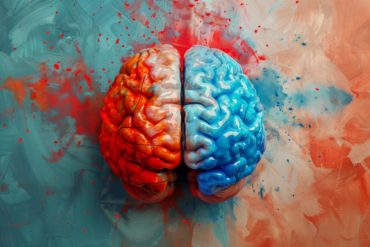Summary: Researchers discover a link between reduced functional activation and reduced cortical thickness in the brains of patients with bipolar disorder.
Source: Elsevier.
A new study in Biological Psychiatry: Cognitive Neuroscience and Neuroimaging using magnetic resonance imaging (MRI) reports a link between reduced functional activation and reduced cortical thickness in the brains of patients with bipolar disorder. The abnormalities were found in patients not currently experiencing depression or mania, which suggests that there is a structural basis for altered neural processing that may help explain why cognitive deficits persist even during periods of normal mood.
Dr. Cameron Carter, Editor of Biological Psychiatry: Cognitive Neuroscience and Neuroimaging, noted the study is “an elegant synthesis of task fMRI and structural MRI” that shows a unique relationship between structure and function in bipolar disorder.
In the first study to assess the relationship between structural and functional MRI data in bipolar disorder, Dr. Shantanu Joshi and his colleagues at the University of California, Los Angeles focused on brain regions that play a role in mood dysregulation in the disorder. They examined the brains of 45 patients with bipolar disorder who were between mood episodes and 45 controls.
While performing a task intended to activate specific regions of the brain, patients had reduced activation, when compared to the control group, in two brain regions critical for inhibitory control: the inferior frontal cortex and anterior cingulate cortex. The patients also had reduced activation in the superior frontal gyrus, a region important for motor planning and decision making.
Structural MRI revealed disease-related reductions in cortical thickness in the same regions: the inferior frontal cortex, anterior cingulate cortex, and superior frontal gyrus. Activation of the anterior cingulate cortex correlated with cortical thickness.

“These brain areas may underlie some of the cognitive difficulties experienced by bipolar patients independent of mood,” Dr. Joshi commented. Until this study, researchers had little insight into the underlying causes of abnormal functional brain activity in the disorder. The findings support the idea that reduced activation in brain regions responsible for inhibitory control could explain impulsivity traits present in bipolar disorder.
“Since these changes were seen in remitted patients they may reflect an ongoing vulnerability related to the pathophysiology of this common and disabling severe mood disorder,” Carter added.
According to Dr. Joshi, the study has potential implications for finding structure-function imaging signatures, known as biomarkers, for bipolar disorder that could be used to inform future intervention studies.
Source: Rhiannon Bugno – Elsevier
Image Source: NeuroscienceNews.com image is in the public domain.
Original Research: Full open access research for “Relationships Between Altered Functional Magnetic Resonance Imaging Activation and Cortical Thickness in Patients With Euthymic Bipolar I Disorder” by Shantanu H. Joshi, Nathalie Vizueta, Lara Foland-Ross, Jennifer D. Townsend, Susan Y. Bookheimer, Paul M. Thompson, d, Katherine L. Narr, and Lori L. Altshuler in Biological Psychiatry: Cognitive Neuroscience and Neuroimaging. Published online July 1 2016 doi:10.1016/j.bpsc.2016.06.006
[cbtabs][cbtab title=”MLA”]Elsevier. “Structural Deficits May Explain Mood-Independent Cognitive Difficulties in Bipolar Disorder.” NeuroscienceNews. NeuroscienceNews, 1 November 2016.
<https://neurosciencenews.com/bipolar-cognition-brain-5406/>.[/cbtab][cbtab title=”APA”]Elsevier. (2016, November 1). Structural Deficits May Explain Mood-Independent Cognitive Difficulties in Bipolar Disorder. NeuroscienceNews. Retrieved November 1, 2016 from https://neurosciencenews.com/bipolar-cognition-brain-5406/[/cbtab][cbtab title=”Chicago”]Elsevier. “Structural Deficits May Explain Mood-Independent Cognitive Difficulties in Bipolar Disorder.” https://neurosciencenews.com/bipolar-cognition-brain-5406/ (accessed November 1, 2016).[/cbtab][/cbtabs]
Abstract
Relationships Between Altered Functional Magnetic Resonance Imaging Activation and Cortical Thickness in Patients With Euthymic Bipolar I Disorder
Background
Performance during cognitive control functional magnetic resonance imaging (fMRI) tasks are associated with frontal lobe hypoactivation in patients with bipolar disorder, even while euthymic. We examine the structural underpinnings for this functional abnormality simultaneously with brain activation data.
Methods
In a sample of 90 adults (45 with interepisode bipolar I disorder and 45 healthy controls), we explored abnormal functional activation patterns in euthymic patients with bipolar disorder during a Go/NoGo fMRI task and their associations with regional deficits in cortical gray matter thickness. Cross-sectional differences in fMRI activation were used to form a priori hypotheses for region of interest cortical gray matter thickness analyses. Blood oxygen level–dependent fMRI to structural magnetic resonance imaging thickness correlations were conducted across the sample and within patients and controls separately.
Results
During response inhibition (NoGo − Go), patients with bipolar I disorder showed significant hypoactivation and reduced thickness in the inferior frontal cortex, superior frontal gyrus, and cingulate compared to controls. Cingulate hypoactivation corresponded with reduced regional thickness. A significant activation by disease state interaction was observed with thickness in left prefrontal areas.
Conclusions
Reduced cingulate fMRI activation is associated with reduced cortical thickness. In the left frontal lobe, a thinner cortex was associated with increased fMRI activation in patients but showed a reverse trend in controls. These findings suggest that reduced activation in the inferior frontal cortex and cingulate during a response inhibition task may have an underlying structural etiology, which may explain task-related functional hypoactivation that persists even when patients are euthymic.
Keywords
Bipolar I disorder; Bipolar euthymia; fMRI; Go/NoGo task; Cortical thickness; Structure–function correlation
“Relationships Between Altered Functional Magnetic Resonance Imaging Activation and Cortical Thickness in Patients With Euthymic Bipolar I Disorder” by Shantanu H. Joshi, Nathalie Vizueta, Lara Foland-Ross, Jennifer D. Townsend, Susan Y. Bookheimer, Paul M. Thompson, d, Katherine L. Narr, and Lori L. Altshuler in Biological Psychiatry: Cognitive Neuroscience and Neuroimaging. Published online July 1 2016 doi:10.1016/j.bpsc.2016.06.006






